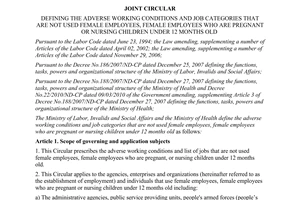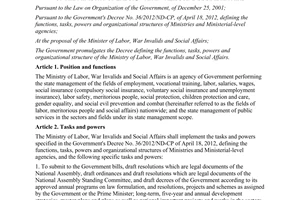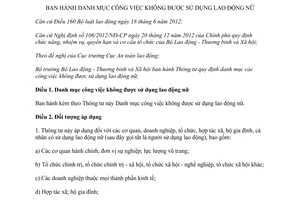Nội dung toàn văn Circular No. 26/2013/TT-BLDTBXH jobs in which the employment of female workers is prohibited
|
THE MINISTRY OF LABOR, WAR INVALIDS AND SOCIAL AFFAIRS |
SOCIALIST
REPUBLIC OF VIETNAM |
|
No. 26/2013/TT-BLDTBXH |
Ha Noi, October 18, 2013 |
CIRCULAR
PROMULGATING THE LIST OF JOBS IN WHICH THE EMPLOYMENT OF FEMALE WORKERS IS PROHIBITED
Pursuant to Article 160 of the June 18, 2012 Labor Code;
Pursuant to the Government’s Decree No. 106/2012/ND-CP of December 20, 2012, defining the functions, tasks, powers and organizational structure of the Ministry of Labor, War Invalids and Social Affairs;
At the proposal of the director of the Occupational Safety Department,
The Minister of Labor, War Invalids and Social Affairs promulgates the Circular providing the list of jobs in which the employment of female workers is prohibited.
Article 1. List of jobs in which the employment of female workers is prohibited
To promulgate together with this Circular the list of jobs in which the employment of female workers is prohibited.
Article 2. Subjects of application
1. This Circular applies to agencies, enterprises, organizations, cooperatives, households and individuals that employ female workers (below collectively referred to as employers), including:
a/ Administrative agencies; non-business units; armed forces;
b/ Political organizations, socio-political organizations, socio-professional organizations and other social organizations;
c/ Enterprises of all economic sectors;
d/ Cooperatives; households;
dd/ Foreign agencies and organizations and international organizations based in the territory of the Socialist Republic of Vietnam;
e/ Other individuals and organizations that employ female workers.
Article 3. Responsibilities of employers
1. Employers may not employ female workers for the jobs on the list promulgated together with this Circular.
2. Based on the list of jobs in which the employment of female workers is prohibited promulgated together with this Circular, employers shall review jobs which female workers are doing and plan job re-arrangement, retraining, occupation change or job change to suit the health of female workers.
3. Employers shall biannually and annually review the implementation of this Circular simultaneously with the review of occupational safety and hygiene work.
Article 4. Responsibilities of provincial-level Departments of Labor, War Invalids and Social Affairs
1. To coordinate with provincial-level Health Departments and Labor Federations in regularly urging, examining and supervising the implementation of this Circular.
2. To enhance inspection to detect and promptly handle violations of regulations on employment of female workers.
3. To annually summarize and report on the implementation of this Circular together with reporting on occupational safety and hygiene work in their localities to the Ministry of Labor, War Invalids and Social Affairs.
Article 5. Implementation provisions
1. This Circular takes effect on December 15, 2013.
2. To annul Joint Circular No. 40/2011/TTLT-BLDTBXH-BYT of December 28, 2011, of the Ministry of Labor, War Invalids and Social Affairs and the Ministry of Health, stipulating hazardous working conditions and jobs in which the employment of female workers and female workers who are pregnant or nursing under-12 month children is prohibited, from the effective date of this Circular.
Any difficulties or problems arising in the course of implementation should be reported to the Ministry of Labor, War Invalids and Social Affairs for consideration and settlement.
|
|
FOR THE MINISTER OF LABOR, WAR INVALIDS AND SOCIAL
AFFAIRS |
LISTS
OF JOBS IN WHICH THE
EMPLOYMENT OF FEMALE WORKERS IS PROHIBITED
(Promulgated together with Circular No. 26/2013/TT-BLDTBXH of October 18,
2013, of the Ministry of Labor, War Invalids and Social Affairs)
Part A
APPLICABLE TO ALL FEMALE WORKERS
I. Jobs in which the employment of female workers is prohibited under Clause 1, Article 160 of the 2012 Labor Code, specifically as follows:
1. Directly boiling and pouring molten metals at the foundries below:
1.1. Electric arc furnaces of a capacity of 0.5 tons or more;
1.2. Pig iron blast furnaces;
1.3. Steel refining drifts;
1.4. Kilns.
2. Rolling hot metal (except ferrous metal).
3. Directly refining non-ferrous metal ores (copper, lead, tin, mercury, zinc and silver).
4. Firing and pouring out coke from ovens.
5. Welding in closed containers, welding in positions which are over 10 meters higher than the working floor.
6. Exploratory drilling, blast drilling.
7. Removing rock on the mountains.
8. Installing offshore oil rigs.
9. Exploratory drilling of oil and gas wells.
10. Regularly working in shifts on offshore oil rigs (except socio-medical services and meal-accommodation services).
11. Maintaining and repairing electric lines in underground tunnels or on open-air posts and high-voltage electric lines and installing high-voltage electric pylons.
12. Maintaining, installing and repairing poles in rivers and antenna towers.
13. Working in sunken tanks.
14. Manually making adjustments in making large sheets or large structures.
15. Manually digging and completing wells.
16. Manually digging up big stumps and cutting down big trees, carrying big logs, levering and loading/unloading big logs, and sawing logs of over 40 cm in diameter; manually sawing and cutting tree branches over 5 m above the ground.
17. Using hand-held machines operated by compressed air with a pressure of 4 atmospheres or more (such as drilling and hammering machines).
18. Operating heavy construction-machines of a capacity of over 36 horse power, such as excavators, bulldozers and crawler vehicles (except hydraulic machines).
19. Painting, repairing, building, plastering, cleaning and decorating on outer surface of high rises (on the third floor or higher or over 12 m above the working floor) without lifting machines or cranes or firm scaffolds.
20. Salvaging for sunken logs, pulling logs in docks, pulling logs ashore.
21. Operating rafts on a river with many cascades.
22. Collecting natural swallow bird’s nests (except in swallow bird-rearing houses); collecting bat guano.
23. Working on seagoing ships (except waiters in restaurants, housekeepers and receptionists in tourist ships).
24. Guarding and watching vessels in docks or on river banks.
25. Operating steam boilers (except automatically operated and oil and electricity-operated ones).
26. Driving trains (except automatically operated trains and trains running in inner cities and tourist routes).
27. Building hulls (of wooden or iron ships) which requires workers to carry or fix weights of 30 kg or more.
28. Surveying river ways with high cascades and dangerous deep mountains.
29. Operating dredgers; driving floating cranes.
30. Driving automobiles of a tonnage of over 2.5 tons (except power-assisted automobiles of a tonnage of under 10 tons).
31. Jobs requiring workers to carry or fix weights of 50 kg or more.
32. Operating starching, dyeing, drying, polish-controlling and shrinking-preventing machines (except automatically operated machines).
33. Rolling and pressing large pieces of hard leather (except automatically operated machines).
34. Driving agricultural tractors of a capacity of 50 horse power or more.
35. Conducting autopsy, shrouding and burying dead persons (except electric incineration), exhuming and moving remains to other places.
II. Jobs in which the employment of female workers is prohibited under Clauses 2 and 3, Article 160 of the Labor Code, specifically as follows:
36. Underwater concreting; divers.
37. Dredging underground sluices (except automatic, machine-operated dredging), regularly soaking body in dirty and fetid water (4 or more hours a day, over 3 days a week).
38. Digging pits; digging well pits; doing jobs in pits (except socio-medical services and extraordinary jobs to meet management and administration requirements, which must comply with current national technical regulations on safety and regulations on health criteria for workers in pits).
Part B
APPLICABLE TO FEMALE WORKERS WHO ARE PREGNANT OR NURSING UNDER-12 MONTH CHILDREN
In addition to the 38 jobs specified in Part A of this List, the employment of female workers who are pregnant or nursing under-12 month children is prohibited in the jobs below:
39. Working in places affected by electromagnetic field in excess of prescribed standards and regulations (such as jobs in radio frequency transmitting stations, radio or television stations, radar stations or satellite telecommunications stations).
40. Working in direct contract with closed and uncovered radioactive sources; working in direct contact with radioactive substances in nuclear facilities; radioactive ore processing facilities; facilities treating and managing used radioactive wastes and sources; facilities exploiting ores with intermediary products or radioactive wastes in excess of the levels eligible for declaration exemption; working in direct contact with radioactive pharmaceuticals in nuclear medicine departments or medical establishments using radioactive pharmaceuticals in therapy and medical examination and treatment.
41. Working in direct contact (producing, transporting, preserving or using) with pesticides, herbicides, termiticides, rodenticides and mosquito killing drugs containing organic chloride and some genetic modification- or cancer-causing chemicals below:
+ 1.4 butanediol, dimethanesulfonate;
+ 2 Naphthylamine;
+ 2,3,7,8 tetrachloral dibenzene furance;
+ 3 - alphaphenyl - beta axetyletyl;
+ 4 - amino, 10 - methyl flolic acid;
+ 4 aminobiphenyl;
+ 5 fluorouracil;
+ Amosite, chrysotile and crocidolite asbestoses;
+ Arsenic, calcium arsenate;
+ Acetylsalicylic acid;
+ Asparagine;
+ Benomyl;
+ Benzol;
+ Boric acid;
+ Insoluble chromate salts;
+ Caffeine;
+ Lead, lead acetate, lead nitrate (being in contact with lead chemicals such as petrol, paint and printing ink; manufacture of batteries, lead welding);
+ Dimethyl sulfoxide;
+ Direct blue-1;
+ Dioxin;
+ Diethylsilboestol;
+ Dichloromethyl-ether;
+ Formamide;
+ Hydrocortisone, hydro-cortisone acetate;
+ Iodine (metal);
+ Potassium bromide, potassium iodide;
+ Vinazol aerosol;
+ Mercaptopurine;
+ N, N-di (Cloroetyl) 2. Naphtylamin;
+ Sodium arsenate, sodium arsenite, sodium iodide, sodium salicylate;
+ Coal tar, coal tar vapor;
+ Nitrogen pentoxide;
+ Mercury, mercury methyl compounds, methyl mercury chloride;
+ Propylthiouracil;
+ Tetramethyl thiuram disulfide;
+ Triamcinolone acetonide;
+ Thori dioxide;
+ Theosulfane;
+ Triton WR - 1339;
+ Trypan blue;
+ Ribavirine;
+ Valproic acid;
+ Vincristine sulfate;
+ Vinyl chloral, vinyl chloride;
+ Cyclophosphamide.
42. Working in direct contact with chemicals causing harms to fetus and breastmilk:
+ 1.1 - dichloro - 2.2-di (4-chlorophenyl) ethane;
+ 1.3 dimethyl - 2.6 dihydroxypurine;
+ 2. Sunfamilamidotazol;
+ 4.4 - DDE;
+ Aldrine;
+ Antimony;
+ Betaquinine;
+ Compounds containing lithium;
+ Calciferol;
+ Chloral hydrate;
+ Decachlorobiphenyl;
+ Penicillin G Potassium;
+ Quinidine gluconate;
+ Strontium (Sr) peroxide;
+ Sulfadiazine, pyridinium sulfate, sodium sulfamethazine, sulfanilamide, sulfamerazine, acetyl sulfisoxazole;
+ Cesium and salts containing cesium (Ce);
+ Cyclosporine.
43. Working in contact with organic solvents such as soaking sleepers, spreading emulsion on photographic paper, printing flowers on thin films, printing labels on thin coated paper, rolling and pressing phenolic resin, and operating phenol-adhesive multi-capacitor boilers.
44. Doing jobs in rubber production: feeding materials, weighing, measuring and sieving chemicals; working in rubber latex furnaces.
45. Repairing airtight steel furnaces and tanks and pipelines in chemical production.
46. Working in tobacco fermentation furnaces or cigarette-drying furnaces.
47. Firing glass-melting furnaces and blowing glass products by the mouth.
48. Soaking, salting and loading/unloading raw hides.
49. Coating paraffin inside wine tanks.
50. Painting, welding or scraping rust in beer fermentation chambers or airtight tanks.
51. Tinning milk in airtight rooms.
52. Removing molds.
53. Processing feathers in open air.
54. Cleansing boilers and gas pipelines.
55. Grinding and feeding ores or doing jobs in working conditions affected by dust containing 10% or more silicon dioxide.
56. Sorting lead ores; rolling, straining and pressing lead products; lead plating.
57. Operating pressing and filtering machines in factories.
58. Operating diesel engines and generators of 10 KVA or more.
59. Operating wire-polishing or wire-spraying machines.
60. Driving agricultural tractors (of any capacity).
61. Driving construction machines (of any capacity).
62. Driving automobiles of a tonnage of under 2.5 tons (except power-assisted automobiles); driving power-operated automobiles and vehicles; driving cranes at sites.
63. Vulcanizing, shaping and loading/unloading large rubber products such as fuel containers and car tires.
64. Carrying or lifting weights of over 20 kg.
65. Being directly involved in investigating, verifying and handling epidemic outbreaks in areas where epidemic infection cases are suspected or confirmed.
66. Shoveling, drying or transporting rotten fish or working in lines producing fish meal for cattle.
67. Stirring and shoveling mud of fish ponds.
68. Working in direct contact with dyes in dyeing plants, such as storekeepers and assistants of chemical warehouses; preparing dyeing chemicals.
69. Operating semi-automatic 4-spout cement packing machines.
70. Installing and repairing very small aperture terminals (VSAT) in deep-lying, remote, highland and border areas and on islands.
71. Regularly soaking body in dirty water, being exposed to infection.
72. Working in places lacking oxygen or in workshops with an air temperature of 40oC or more in summer or 32oC or more in winter.
73. Working in places affected by vibration in excess of national regulations or standards; using machines and devices with whole and partial vibration in excess of levels prescribed in national regulations or standards.
74. Working in uncomfortable posture and in narrow space which occasionally requires workers to lie, bow or bend.
75. Delivering, receiving, preserving or operating pumps and measuring petrol and oil in trenches; delivering and receiving petrol and oil at sea.
76. Operating lead founding and casting devices in battery production.
77. Operating devices producing and casing yellow phosphorous.-



